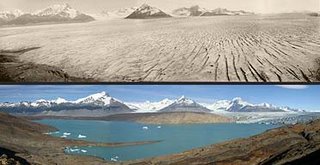
View from the top ...
Two images of the Upsala glacier in Argentina show the retreat of the ice (top: 1928; bottom: 2004).
Photograph: Greenpeace/Reuters
This article shows how climate change and the global water crisis are inextricably linked to each other. Just keep burning those fossil fuels.
Cities in peril as Andean glaciers melt
Ice sheets expected to last centuries could disappear in 25 years, threatening water supplies
John Vidal, environment editor
Tuesday August 29, 2006
Andean glaciers are melting so fast that some are expected to disappear within 15-25 years, denying major cities water supplies and putting populations and food supplies at risk in Colombia, Peru, Chile, Venezuela, Ecuador, Argentina and Bolivia.
The Chacaltaya glacier in Bolivia, the source of fresh water for the cities of La Paz and El Alto, is expected to completely melt within 15 years if present trends continue. Mount Huascarán, Peru's most famous mountain, has lost 1,280 hectares (3,163 acres) of ice, around 40% of the area it covered only 30 years ago. The O'Higgins glacier in Chile has shrunk by nine miles in 100 years and Argentina's Upsala glacier is losing 14 metres (46ft) a year.
Although a few glaciers in southern Patagonia are increasing in size, almost all near the tropics are in rapid retreat. Some glaciers in Colombia are now less than 20% of the mass recorded in 1850 and Ecuador could lose half its most important glaciers within 20 years.
The rate of glacier retreat has shocked scientists, says a report on the effects of global warming in Latin America by 20 UK-based environment and development groups who have drawn on national scientific assessments. Their study says climate change is accelerating the deglaciation phenomenon.
"The speeding up of the ... process is a catastrophic danger," says Carmen Felipe, president of Peru's water management institute. In the short term, the president says, it could cause overflows of reservoirs and trigger mudslides, and in the longer term cut water supplies.
According to the Colombian institute of hydrology, back in 1983 the five major glaciers in El Cocuy national park were expected to last at least 300 years, but measurements taken last year suggest that they may all disappear within 25 years. Meanwhile, the ice sheet on the Ecuadorean volcano Cotopaxi and its glacier has shrunk by 30% since 1976.
"The [drastic melt] forces people to farm at higher altitudes to grow their crops, adding to deforestation, which in turn undermines water sources and leads to soil erosion and putting the survival of Andean cultures at risk," says the report by the Working Group on Climate Change and Development, which includes the International Institute for Environment and Development, Christian Aid, Cafod, WWF, Greenpeace and Progressio.
Their report, Up in Smoke, says snow and rainfall patterns in South America and the Caribbean are becoming less predictable and more extreme. "East of the Andes, rainfall has been increasing since about 1970, accompanied by more destructive, sudden deluges. Meanwhile, the last two hurricane seasons in the Caribbean rim have caused $12bn (£6.3bn) damage to countries other than the US. Tropical storms are expected to become more destructive as climate change intensifies. Climate change models predict more rainfall in eastern South America and less in central and southern Chile with a likelihood of greater and opposite extremes. The 2005 drought in the Amazon basin was probably the worst since records began."
End of excerpt.
View Of Chacaltaya Glacier
Absolutely UNBELIEVABLE.
~~~~~~~~~~~
Water scarcity is simply again not just the process of fixing leaky pipes. Although infrastructure is absolutely one of the top concerns and priorities regarding this global crisis, this report and article clearly illustrate that human behavior is also contributing to the water crisis in our world. Weather patterns particularly regarding rainfall also show in some cases not just a shift in patterns, but a complete reversal. The effects of these glaciers melting completely will then be past crisis stage if the people who depend on the freshwater provided from them and a rainfall they cannot depend on are left with nothing to use for farming and other needs. Higher elevation farming will only lead to soil erosion and deforestation which in turn will then lead to flooding of crops, and effect the very way of life for thousands of people who without water to survive would then have no choice but to migrate elsewhere.
Also see;

Amazon Drought Widens




No comments:
Post a Comment